Hoka One One EVO Jawz
Test Locations: Gunnison & Durango, CO; San Juan County, UT
Test Duration: 95 miles
Stated Stack Height: 23 mm (heel) / 20 mm (forefoot)
Stated Heel-to-Toe Drop: 3 mm
Stated Features:
- Woven rip-stop upper designed for durability and fit security
- Moderate active foot frame for maximum tuned stability
- PROFLY™ midsole for a cushioned landing and propulsive toe-off
- Vibram® Megagrip hi-traction outsole with 6 mm lugs
- Multidirectional lugs for supreme grip on varied terrain
MSRP: $ 130.00
Size Tested: US Men’s 11.5
Stated Weight per Shoe (US Men’s Size 9): 204 g / 7.2 oz
Blister Measured Weight per Shoe (US Men’s Size 11.5): 250 g / 8.8 oz
Reviewer (Runner Profile): 6’1”, 145 lbs
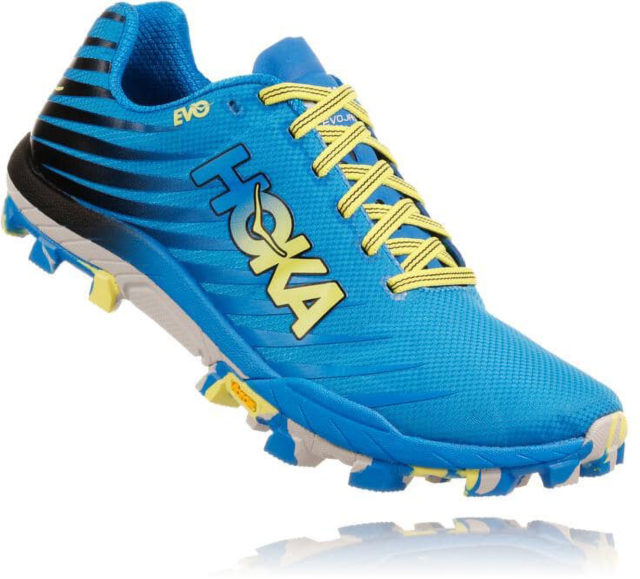
Intro
At this point, just about every major trail running shoe brand now has at least one model in their lineup that’s designed for sloppy, muddy conditions and / or obstacle course racing. Salomon has the S/Lab Speed 2 and Sense 8 SG, Altra’s got the King MT 2, La Sportiva has the Mutant, and Inov-8’s got more mud-specific shoes than I can keep track of. But until recently, Hoka’s trail running shoe lineup didn’t have any shoes designed exclusively for extra muddy, technical terrain.
Enter the very aptly named Hoka One One EVO Jawz. The EVO Jawz is a bit of a departure from the maximal, plush shoes that Hoka is best known for, featuring a fairly moderate stack height and very deep, widely spaced lugs. It’s designed to be a light, close-fitting shoe for running fast on loose, muddy, and / or technical terrain. I’ve run in a few mud shoes from brands like Salomon and Inov-8 over the last couple years, so I was curious to see how Hoka’s foray into the world of low-stack, high-traction shoes would compare to similar offerings from other brands that have been doing it for a while.
After just short of 100 miles in the EVO Jawz, I’ve come to the conclusion that, while the shoe does have some quirks, it’s probably the most versatile “mud-specific” shoe I’ve used.
Fit
As with any shoe, it’s best to try on the EVO Jawz yourself before you buy it, if at all possible. With that in mind, I’ll add my two cents on how the EVO Jawz fits my fairly narrow / low-volume feet.
Hoka’s shoes tend to be slightly on the narrower side and the EVO Jawz follows this trend, for the most part. Its midfoot and heel feel narrower than the EVO Speedgoat, which I think makes sense for a performance-oriented shoe designed specifically for technical terrain where foot stability is important. Still, if you’ve got wide feet, the EVO Jawz’s tight fit might be a bit uncomfortable. The EVO Jawz does feel like it’s got a fairly similar amount of space in the forefoot vs. the EVO Speedgoat — it’s definitely not a wide toe box, but there is enough space so that my toes don’t get smashed together.
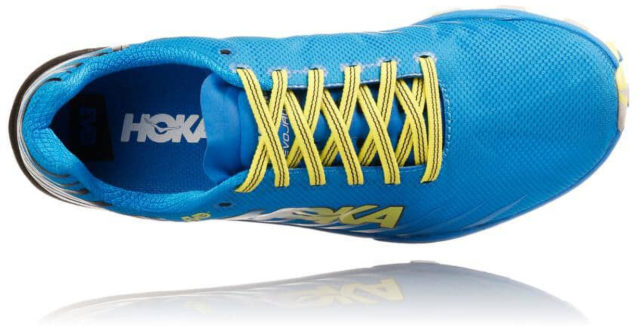
On the whole, the EVO Jawz feels fairly similar to the Salomon S/Lab Sense 8 as far as fit is concerned. If you’ve read my review of the Sense 8, you’ll know that I view that as a good thing. On my feet, the EVO Jawz feels locked-down without being confining. And while it’s not as spacious as a shoe like the Altra Timp 2.0, the EVO Jawz is still comfortable for my feet on runs up to 3 hours long. I’ve also never had any issues with blisters or hot spots in the EVO Jawz, which is more than I can say for the Sense 8.
Weight (and Comparisons)
The EVO Jawz is very light. That doesn’t come as much of a surprise, considering that it’s designed for racing, but it’s still impressive for the level of protection and traction that the shoe provides. For comparison, here’s how the EVO Jawz’s weight compares to the stated weights of similar shoes from other brands. All weights are based on a US Men’s Size 9:
204 g / 7.2 oz — Hoka One One EVO Jawz
210 g / 7.4 oz — Salomon S/Lab Sense 8 SG
212 g / 7.5 oz — Inov-8 X-Talon 212 V2
260 g / 9.2 oz — Inov-8 X-Talon Ultra 260
266 g / 9.4 oz — Salomon S/Lab Speed 2
281 g / 9.9 oz — Altra King MT 2
So, when you compare shoes with deep lugs and moderate cushioning, the EVO Jawz is pretty hard to beat from a weight standpoint. The Salomon S/Lab Sense 8 SG and Inov-8 X-Talon 212 V2 are close enough that you probably wouldn’t be able to feel much of a difference between them and the EVO Jawz once you’re on the trail, but the fact remains that the EVO Jawz is one of, if not the lightest mud-specific shoe around (as far as I know).
Upper
The EVO Jawz has a woven ripstop upper that feels slightly similar to the Hoka EVO Speedgoat’s upper; it’s not the same MATRYX material used on the EVO Speedgoat and EVO Mafate, but it does perform similarly. The EVO Jawz’s upper is extremely thin and light, which I like, but it’s also a bit less stretchy / flexible than the standard mesh found on most shoes. Because I have very low (ok, pretty much flat) arches, the upper bunches up a little bit around the bottom of the lacing system when I tighten the laces. The ripstop upper doesn’t really stretch at all, so when it does bunch up, I can feel the creases against the top of my forefoot more than I would in a softer / stretchier upper. I usually don’t notice this at all once I actually start running, but it can be a bit annoying.
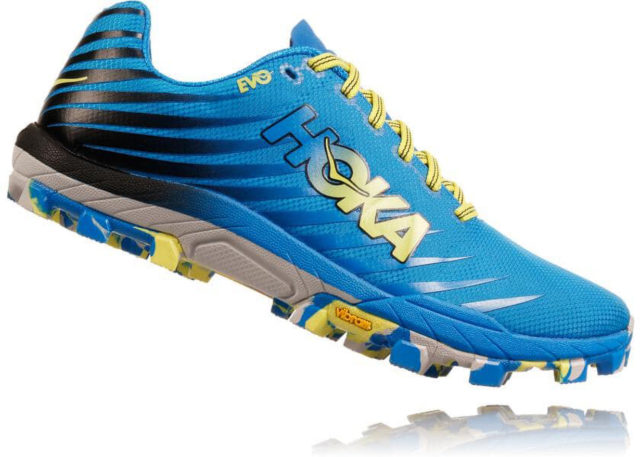
The EVO Jawz’s tongue is also a little unusual — it’s firmly attached to the upper with similarly inflexible materials, so getting your foot into the shoe can be a bit tricky. Once it’s on though, the more rigid feel through the midfoot does provide a very secure-feeling fit. I’ve also noticed that the EVO Jawz’s upper bleeds lots of blue dye onto my socks / feet pretty much every time I run in the shoe. I thought this would stop after the first few runs, but it still seems to be going strong after 95 miles. Obviously, it doesn’t impact the shoe’s performance at all, but it is kind of obnoxious — if you do end up buying the EVO Jawz, don’t plan on wearing them with your favorite pair of white socks.
Aside from those minor complaints, the EVO Jawz’s upper performs very well. It doesn’t soak up any water, which helps the shoes drain extremely fast after creek crossings. While it doesn’t feature any specific drain holes, the upper is porous enough that it lets water out of the shoe quickly and the non-absorbent nature of the ripstop material helps the shoes avoid the waterlogged feeling that some shoes get after creek crossings. The woven ripstop upper isn’t quite as breathable as a more traditional mesh upper, but it’s not overly hot either. I’ve worn the EVO Jawz in temperatures up to 70º F / 21º C without too much extra foot sweat.
Midsole
I think Hoka’s PROFLY midsole is a big part of what makes the EVO Jawz a much more versatile shoe than other mud shoes I’ve run in. In my experience, shoes designed specifically for sloppy, technical terrain tend to feature fairly minimal, extremely firm cushioning. This makes sense for the most part — you need fairly firm cushioning and good ground feel in order to feel secure and confident on loose terrain. But any time I’ve tried to go on a longer (2+ hour) run in shoes like the Salomon S/Lab Sense 6 SG or Inov-8 X-Talon 212, my feet get pretty beat up by those shoes’ extremely firm midsoles.
For me, the EVO Jawz’s midsole is firm enough that it doesn’t feel overly soft / sloppy on technical terrain, but it’s noticeably softer and more comfortable than any other mud-specific shoe I’ve used. Don’t get me wrong, the EVO Jawz still isn’t a highly cushioned shoe, and it feels fairly firm underfoot. But the midsole has enough “give” to it that the EVO Jawz has still felt comfortable after 3 hours in the shoe. The slightly softer cushion does make the EVO Jawz slightly less efficient in terms of energy return compared to a firm shoe like the Salomon S/Lab Sense 8, but the Evo Jawz still feels plenty fast and nimble when I pick up the pace. And despite its fairly low stack height and lack of a rock plate, I haven’t had any pain or issues running in the EVO Jawz on very rocky terrain.
It’s also worth noting that, like many shoes in this class, the EVO Jawz has a pretty minimal heel-to-toe drop of 3 mm. That’s great for striking with your forefoot, but it does not encourage a heel-to-toe transition like many shoes with higher drops do.
Outsole
The outsole is arguably one of the most important components of any mud-specific shoe, and the EVO Jawz’s outsole does not disappoint. Its widely spaced, 6 mm lugs have provided plenty of grip on just about every surface imaginable — I’ve still slipped in the EVO Jawz a few times when running through ankle-deep mud with the consistency of peanut butter, but I’d be amazed if I found a shoe that didn’t slip a little in those conditions. Aside from that, I’ve never wished for more traction when running in the EVO Jawz. The tread pattern also does a good job of releasing mud when you lift your foot, which helps limit the obnoxious mud “high-heels” that often build up in especially sticky conditions.
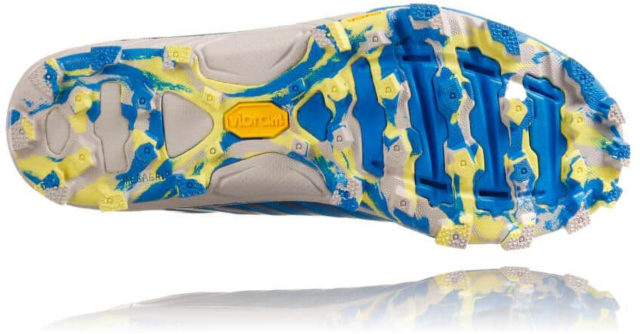
The EVO Jawz’s large lugs do feel slightly awkward on hard, smooth trails, but I can still run less technical sections of trail without feeling like I’m going to trip over them — and that’s really not the kind of terrain that the EVO Jawz is designed for. (And yes, we are well aware that the photos here don’t show off super muddy terrain, but rest assured, I did spend a lot of time running in this shoe in more appropriate terrain / conditions.)
The EVO Jawz uses the same Vibram Megagrip rubber found on the Hoka EVO Speedgoat, which I think is a definite improvement over the proprietary outsole compounds that most brands use on their shoes. The EVO Speedgoat’s outsole offered a better balance of sticky grip and durability than just about any other shoe I’ve run in, and the same holds true for the EVO Jawz. The Megagrip outsole provides plenty of grip on wet rocks and roots, but it’s also holding up much better than the sticky rubber outsoles of the Salomon S/Lab Sense 7 SG or Inov-8 X-Talon 212. The EVO Jawz’s outsole does have some noticeable wear in high-impact areas in the forefoot, but it’s still got plenty of life left in it.
On Trail
Most mud-specific shoes are just that: they’re great on technical, muddy terrain, but not on much else. Shoes like the Salomon S/Lab Sense 6 SG or Inov-8 X-Talon 212 feel secure and fast when the trail surface gets loose, but they’re way too firm and minimal to feel comfortable to me on longer runs of more varying terrain.
As someone who often does longer runs that include significant sections of muddy, technical terrain, this creates a bit of a dilemma. Shoes that feel comfortable for my feet on longer (2-3+ hour) runs like the Altra Timp 2.0 don’t offer great traction in mud, but mud-specific shoes that do provide ample traction aren’t typically comfortable for runs that long.
After 95 miles in the shoe, the EVO Jawz feels like the more comfortable, long-distance-ready mud shoe that I’ve been looking for. My first few runs in the EVO Jawz were limited to what I imagined the shoe would be good for — shorter, faster efforts on technical and / or muddy trails. The EVO Jawz felt just as secure and grippy as the Salomon S/Lab Sense 6 SG or Inov-8 X-Talon 212 on those kinds of runs, but it also felt much more cushioned and comfortable.
I was curious to see if the EVO Jawz would still feel comfortable after several hours in the shoe, so I tried them out on a few 3-hour runs that included lots of muddy, loose terrain. I’m happy to report that my initial impressions held true on longer outings as well — the EVO Jawz is easily the most comfortable mud shoe I’ve run in. The slightly thicker, softer midsole provides just enough cushion to prevent the foot fatigue I’ve experienced in stiff / minimal shoes like the X-Talon 212 without sacrificing a close-to-the-ground, secure, nimble feel.
The EVO Jawz doesn’t feel quite as smooth on non-technical terrain as shoes like the Salomon Sense 4 /Pro or Nike Terra Kiger 5, but the EVO Jawz’s softer cushioning does make it feel less awkward than other mud-specific shoes I’ve used when it comes to smooth trails. I’d still choose a shoe like The Sense 4 /Pro or Terra Kiger 5 over the EVO Jawz for runs exclusively on dry, less technical trails, but the EVO Jawz’s extra traction has quickly made it my go-to shoe for muddy, technical runs of just about any length.
Durability
I’ve only put 95 miles on the EVO Jawz so far (due to an injury), but it seems like they’re holding up quite well. The outsole lugs have worn down a little in high-wear areas of the forefoot and heel, but it hasn’t impacted the shoe’s performance at all. The upper doesn’t have any fraying or concerning wear, and the midsole feels the same as it did out of the box. Obviously, it’s hard to draw any certain conclusions about the EVO Jawz’s long-term durability after only 95 miles in the shoe, but things are looking good so far — especially given how lightweight this shoe is and how sticky its outsole is. If I run into issues with the shoe’s durability down the line, I’ll update this review.

Who’s It For?
While I do think it’s more versatile than other mud-specific shoes I’ve used, the EVO Jawz is still a fairly specialized shoe. Its slightly softer midsole makes it more comfortable for longer runs vs. similarly mud-specific shoes, but it still feels most at home on very technical, loose terrain. So if you’re looking for one running shoe for all of your normal training runs, a shoe like the Altra Timp 2.0, Salomon Sense 4 /Pro, or Nike Terra Kiger 5 would probably be a better choice.
But if you’ve already got a pair of shoes for dry, less technical trails, the EVO Jawz is a compelling option to add to your lineup for more technical / muddy runs. It feels fast and nimble on technical terrain, and its softer cushioning makes it more comfortable for longer runs than other mud shoes that I’ve run in.
Bottom Line
It often takes brands a few tries to really figure out a new category / type of shoe, but I think Hoka One One pretty much nailed their first attempt at a mud-specific shoe with the EVO Jawz. As you’d expect of a shoe in this class, it’s secure, grippy, and minimal. But it’s also got enough cushion for longer runs (for me, 2+ hours), which is more than I can say for mud shoes I’ve run in from brands like Salomon or Inov-8. While the EVO Jawz’s narrow midfoot and heel might make it less comfortable for runners with wider feet, I think it’s a great option for runners who like a close-fitting mud shoe that’s up to the challenges presented by longer runs.


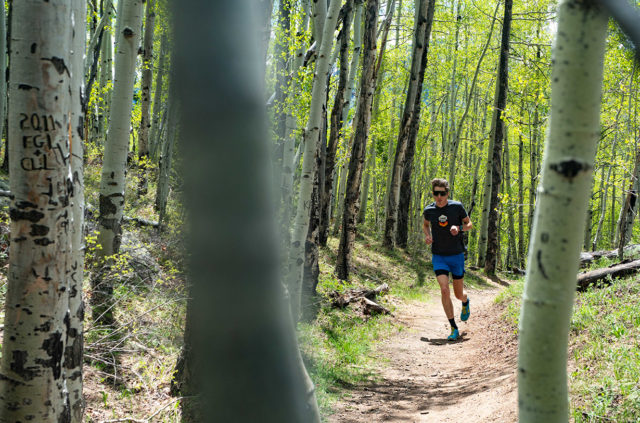
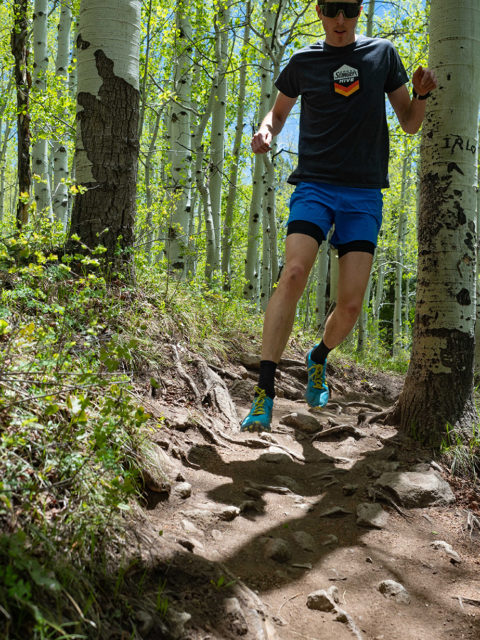

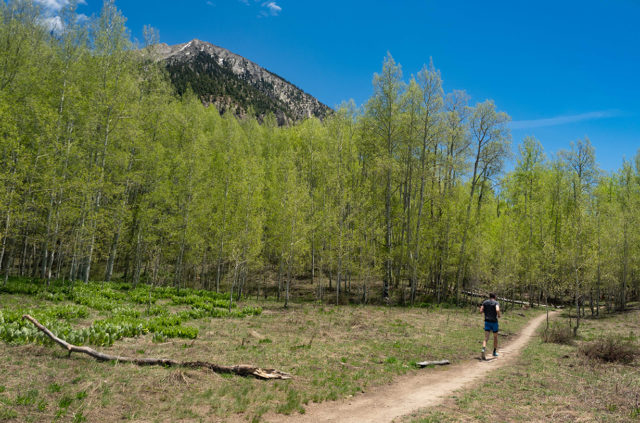
thanks very interesting report